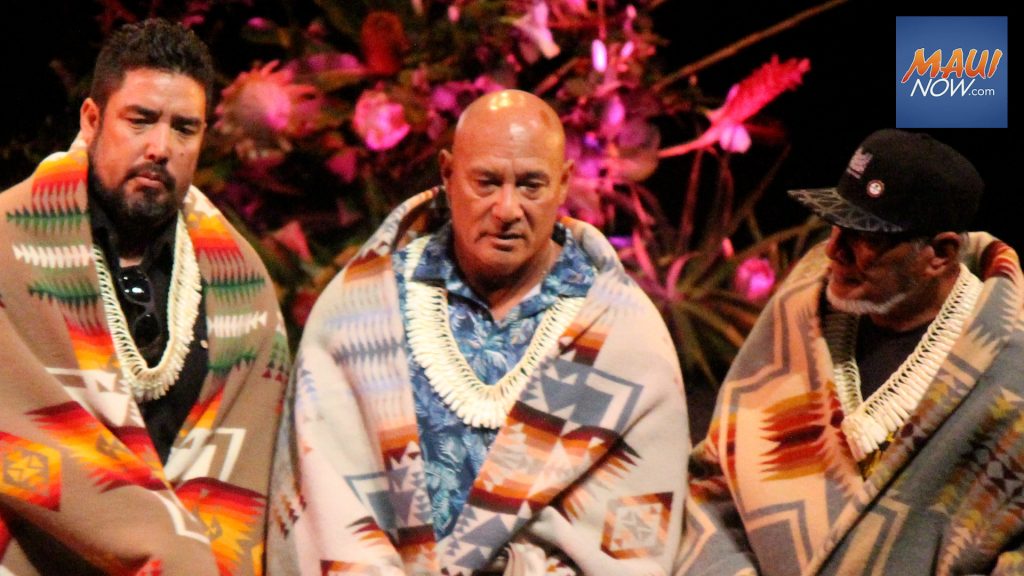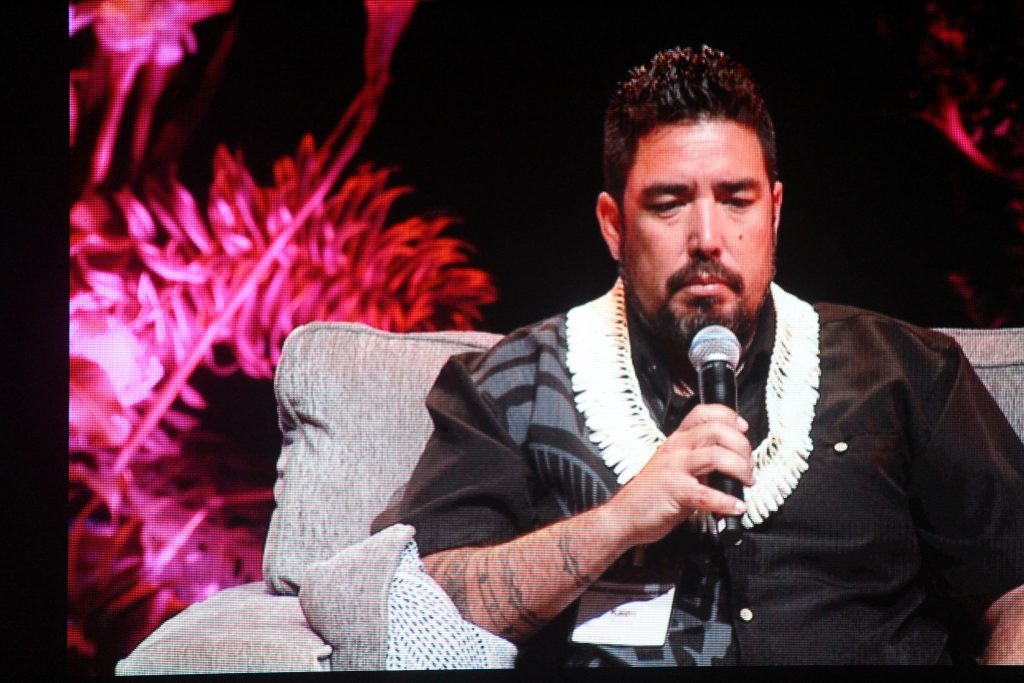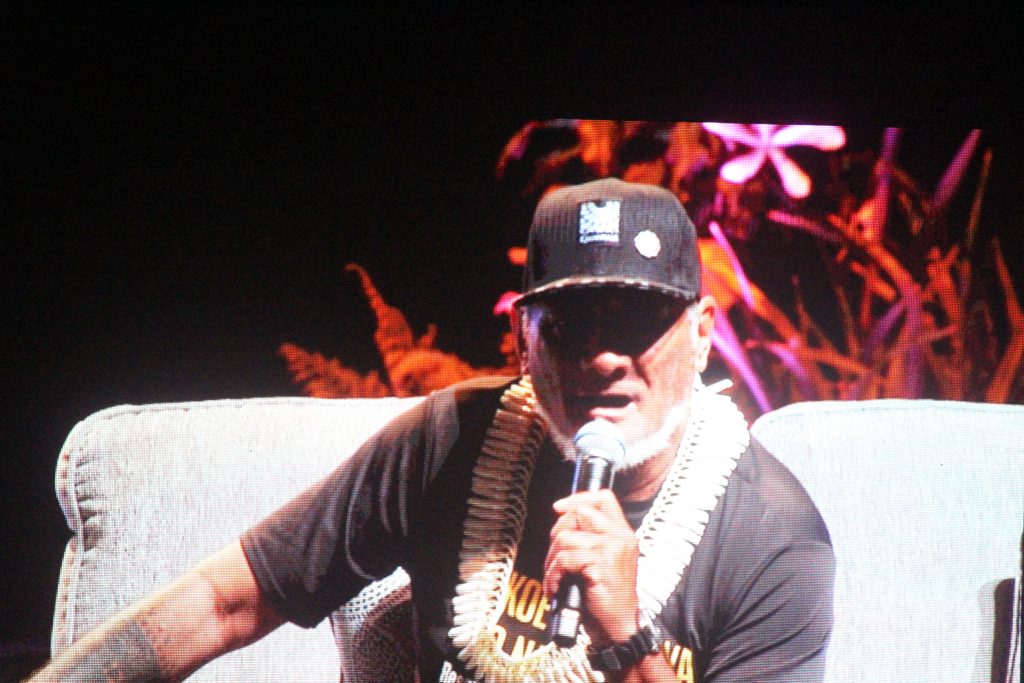Lahaina’s Vision for the Future, Part 1: Memories of Lahaina
Three residents of West Maui joined in a panel discussion Wednesday on their vision for the future of Lahaina. It is one of many presentations being held at the 22nd Annual Native Hawaiian Convention, taking place this week at the Maui Arts & Cultural Center in Kahului.
The wildfires and their destructive aftermath created a prominent backdrop in the discussions about Lahaina. The three reflected on nostalgic moments as they shared their earliest memories of Lahaina.
This is Part 1 in a 3 part series.

Residents Kaipo Kekona, Archie Kalepa and Keʻeaumoku Kapu shared their thoughts in a discussion moderated by Summer Sylva.
Kaipo Kekona grew up on Olona Place, just off of Front Street, at the north end. He recalled the families that surrounded him in his youth: the Felicilda’s, Neizman’s, Dizon’s, Keahi’s and Lukela’s.
“I got to grow up playing with all of them, running around from when we were in our diapers, clear up to when we were racing on the streets on our pedal bikes. That would be one of my earliest, fondest memories… building tree houses in somebody’s yard,” he said.
ARTICLE CONTINUES BELOW AD“Those were fun times that I can say built not only a foundation, but a pilina (relationship) with lifelong families. Until today, we still maintain those relationships. That is one of the most memorable moments for me… and also a reminder that there is a broad representation in our community that needs to be at the forefront of these conversations.”
-Kaipo Kekona

Archie Kalepa described the smell of flowers, a simple town before tourism, and a history that he would later come to understand with grater appreciation.
Both of his parents graduated from Lahainaluna High School in 1957. “My dad joined the military and we left Lahaina, but I came home every summer to be with my grandfather, Dallas Kalepa [Sr.], and my mom’s parents, Frank and Adelaide Sylva,” he said. “My grandpa Kalepa lived on Front Street, and my grandmother and Grandpa Sylva lived on Luakini Street.”
“I remember coming home and driving down Puamana, and smelling the flowers. That’s when I knew I was home.”
-Archie Kalepa
“My grandfather, was in charge of the armory, and back then, Lahaina Shores wasn’t there. But there was a little area behind the armory—what was left of the fishpond. I remember my grandfather throwing net in that fishpond and catching mullet,” Kalepa recalled.
“I also remember going to the Lahaina Theater—watching movies with my brother and sister who lived on Maui, and used to go home late at night. Back then, nobody had a car. We walked everywhere, and I remember running once I got to Malu Ulu o Lele Park because we were deathly afraid of the Moʻo Lady,” he said with a laugh, “because of the stories our cousins told us.”
“I just remember the community. Lahaina, Front Street was empty,” Kalepa said, listing a few stores including Arakawa Store and Ben Franklin.
“It was such a small and beautiful town, and everybody knew everybody. The town that I grew up in, or was a part of, was really different,” he said.

But just as his memories of Lahaina were different from the generation that followed, they also differed from those of his elders.
As a waterman, Kalepa recalled trying to get the Jr. Lifeguard program started for Maui. “We invited all the schools and there were 250 kids… there was the Lahaina Restoration Foundation—they were going to talk about the old places of Lahaina,” he said.
“My grandfather came and he gave me scoldings—’That’s not the real Lahaina. You need to talk about the real history of Lahaina.’ I never understood what he was saying until he passed away, and then I got it. The real history of Lahaina was Mokuʻula,” he said.
“He knew so much of the old history of Lahaina—That’s my grandfather. I just wish I would have paid more attention. But the memories I have of Lahaina, like so many of you up there, has always been fond memories. That brings us back home. I just hope we can find that again.”
-Archie Kalepa
For Keʻeaumoku Kapu, life for him in Lahaina started in the 1980s.
“I wasn’t born here. I was born on Oʻahu. My dad, Paul Kekai Kapu, was born in Kaua’ula Valley in 1932. By 1947, my dad was exiled from Maui. It’s kind of a sad story, but I don’t ponder on the past. I just try to think on ways of how we need to go forward in this fight of some pilikia that had occurred and happened to my ʻohana,” said Kapu.
“I think the greatest moment was when my dad took us home,” said Kapu.
“It seemed like when we went to Kauaʻula Valley, he took us back into his footsteps, took us into the valley, disappeared in the bushes saying that he needed to look for something. He came out and he found his poi pounder that he left there 60 years ago, but proof enough for us to say that we are of this place.”
-Ke’eaumoku Kapu

“Things only resonated more and more from there on how looking up from the mountains down at the town to see the different lifestyle, which normal people don’t get the opportunity to see because they’re all too busy looking from the bottom, up, of how bountiful and beautiful the panoramic views of this West Maui regions are. I’ve seen things differently, and things that have changed drastically.”
-Keʻeaumoku Kapu
Nonetheless, Kapu said it gave him the eagerness within himself to gather thoughts from the younger generations, and gather manaʻo (thoughts) from kupuna of Lahaina.
“I was infatuated to learn a lot. I went all over Lahaina looking for the oldest kupuna to share manaʻo—what they remembered and whether or not they remembered anything about my great-great-grandfather. His name was Manuia Kekai,” said Kapu.
From that research, Kapu said he found his extended ʻohana and all the intricate connections that exist.
“That’s the greatest moment of my life,” he said—knowing those connections.
“It kind of makes me proud to know that I’m fighting for the right cause… because of all of you,” he said.
*Check back for more in this series. The Native Hawaiian Convention presented by the Council for Native Hawaiian Advancement continues through Friday at the Maui Arts & Cultural Center in Kahului.








